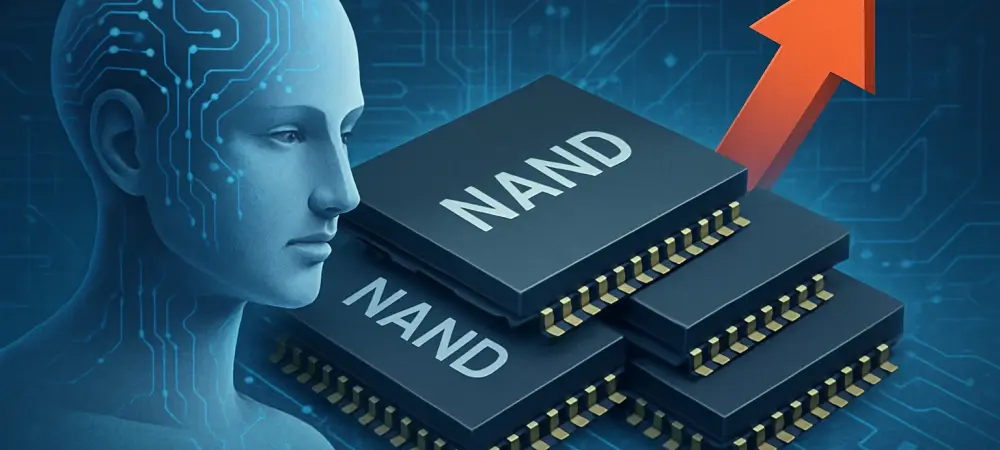Today, we’re thrilled to sit down with Dominic Jainy, a seasoned IT professional whose deep expertise in cutting-edge technologies like artificial intelligence, machine learning, and blockchain offers a unique perspective on the evolving landscape of memory markets. With the NAND industry experiencing unprecedented demand and dramatic price shifts, as highlighted in recent reports from leading suppliers, Dominic is here to unpack the forces driving these changes. In our conversation, we’ll explore the extraordinary dynamics of the current NAND market cycle, the impact of AI on storage demand, the reasons behind skyrocketing prices, and what this all means for consumers and the industry’s future.
Can you walk us through the current state of the NAND market and why it’s being described as a cycle unlike any other?
Absolutely. The NAND market right now is in a truly remarkable phase. Industry leaders have noted that the demand we’re seeing is unprecedented, something they’ve never witnessed before. This isn’t just a typical uptick; it’s a dramatic shift driven by new technological needs, particularly from AI applications. Unlike past cycles where demand was more predictable and tied to consumer electronics, this surge is fueled by a broader, more complex set of requirements that are reshaping how storage is utilized across industries.
What’s behind the massive price increases for NAND, especially for TLC memory, which has jumped 50-75% in just a few months?
The price surge for NAND, particularly TLC memory, comes down to a perfect storm of high demand and constrained supply. AI and data center applications are consuming NAND at an incredible rate, far outpacing what suppliers anticipated. At the same time, production hasn’t scaled up quickly enough to meet this need, partly because facilities have been underutilized for months prior to this boom. When demand spikes like this without a matching supply increase, prices naturally skyrocket, and we’re seeing that reflected in these dramatic hikes over such a short period.
How is the rise of AI influencing the demand for NAND-based storage like SSDs?
AI is a game-changer for NAND storage. In the era of AI inference, where models are constantly processing and updating, there’s a huge need for fast, reliable storage solutions. SSDs, which rely on NAND, are critical in data centers for things like storing AI models and enabling low-latency startups. Every time a model updates, those changes need to be reflected in storage, and NAND-based drives are ideal for handling that workload. This insatiable appetite from AI environments is driving demand to levels we’ve never seen before.
There’s talk of a ‘tight market’ for NAND supply. Can you explain what that means and how it impacts consumers?
A ‘tight market’ essentially means there’s not enough NAND supply to meet the current demand. For consumers, this translates to higher prices for products like SSDs and other storage devices. It also means potential delays or shortages when trying to purchase these items, especially for high-capacity models. Manufacturers are struggling to keep up, and until supply chains adjust, everyday buyers might find it harder to get their hands on affordable storage solutions.
Why have NAND production facilities been underutilized for so long, even before this demand spike?
For the past few years, NAND suppliers have been very cautious about expanding production. Since the COVID period, the industry has faced a demand drought, and profits have been either flat or nonexistent for many companies. Expanding facilities or building new fabs is a massive investment, and without a clear sign of sustained demand, companies held back. They didn’t want to overcommit and get stuck with excess capacity, so they’ve been running at lower utilization rates until very recently.
Given this new wave of AI-driven demand, do you think NAND suppliers will start ramping up production soon?
I believe we’ll see a gradual increase in production, but it won’t happen overnight. The unprecedented demand from AI is a strong signal to suppliers that it’s time to invest, but they’ll likely remain cautious after years of slim margins. Building new facilities or scaling up existing ones takes time and significant capital, so while I expect production to rise over the next year or two, the immediate supply constraints will probably persist for a while longer.
How have the challenges since the COVID period affected NAND suppliers’ profitability, and what’s changing now?
Since COVID, NAND suppliers have struggled with inconsistent demand and oversupply at times, which eroded their profitability. The market was volatile—consumer demand dropped in some areas, while other sectors didn’t pick up the slack. Many companies were just breaking even or operating at a loss. Now, with this AI-driven demand spike, the outlook is much brighter. Prices are rising, and for the first time in years, suppliers are seeing a path to meaningful profits, which could encourage more investment in the sector.
What should everyday consumers expect from these rising NAND prices when it comes to buying storage devices?
Consumers should brace for higher costs, especially for SSDs and other NAND-based storage devices. With prices already climbing significantly, products with higher storage capacities are likely to become even more expensive in the near future. If you’re thinking about upgrading your PC or buying a new drive, now might be the last window to snag a deal before prices climb further. The upcoming sales season could be a critical time to act.
Looking ahead, what’s your forecast for the NAND market over the next few years?
I think the NAND market will remain dynamic and challenging for the next couple of years. The demand from AI and data centers isn’t going away; if anything, it’s likely to grow as more industries adopt these technologies. However, supply will eventually catch up as suppliers ramp up production, though that could take time. Prices may stabilize, but I don’t expect them to drop back to pre-surge levels anytime soon. We’re in for a period of adjustment where both innovation and investment will shape how accessible and affordable NAND storage becomes.

